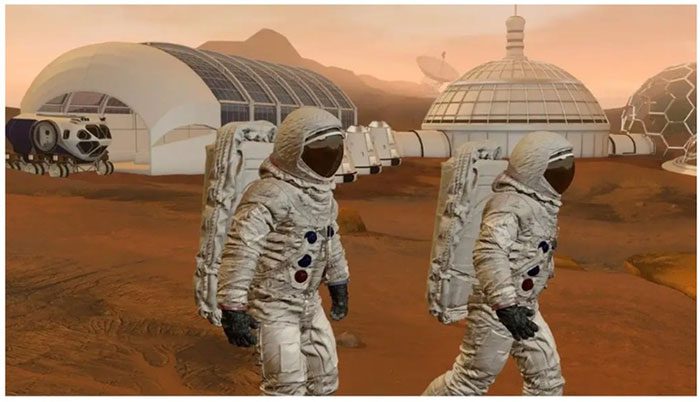Achievements in space exploration have opened up prospects for humanity to conquer the vast and mysterious universe.
Achievements in space exploration, including sending astronauts to the Moon, and sending rovers to Mars, have opened up prospects for humanity to conquer the vast and mysterious universe. However, the question of when we will colonize other planets and establish human settlements remains a challenging one.
Prospects for Colonizing Mars
Elon Musk, the CEO of SpaceX, envisions a city of one million people on Mars by 2050. This is an ambitious astronomical idea, as humans have yet to set foot on the surface of Mars.
But is this feasible? How long will it take for humanity to colonize another planet? Can we even conquer worlds beyond our solar system?
For Mars, a few decades may not be an unrealistic timeframe. Serkan Saydam, Deputy Director of the Australian Space Research Centre and a Professor at the University of New South Wales in Sydney, stated that human colonization of Mars could occur within the next few decades. “I believe that by 2050 there will be a human colony on Mars,” he told Live Science.
According to Saydam, the most critical issue for establishing a colony on Mars is water. Water can be extracted from ice or hydrated minerals, facilitating agriculture and the ability to grow food crops. Meanwhile, hydrogen from ice and minerals could be used as an energy source for rocket engines.
However, there is no scientific consensus about colonizing Mars by 2050, and other researchers have expressed less optimistic views.
Louis Friedman, a space engineer and co-founder of the nonprofit organization The Planetary Society, expressed to Gizmodo in 2019 that colonizing Mars is unlikely to happen in the near future, while Rachael Seidler, a neuroscientist at the University of Florida who has worked with NASA astronauts, described the idea of colonizing Mars as “somewhat fanciful.”
Despite this, landing on Mars and laying the groundwork for long-term settlement is no longer a distant dream. China plans to send astronauts to the Red Planet by 2033, while NASA aims for this goal by the late 2030s or early 2040s. Once humans reach Mars, the next step could be to establish a colony.
A colony is expected to be a place where residents can achieve a certain level of self-sufficiency but cannot be entirely independent from Earth. Saydam compares Mars to a remote island, where residents occasionally need to import essential goods.
To ensure long-term financial stability, a colony on Mars would need to engage in certain activities. Space tourism is one option, but Saydam emphasizes that mineral extraction is the key to success in the colonization process.
When Will We Reach Exoplanets?

Will humans settle on Mars in a few decades?
While Mars is the most practical option for our extraterrestrial settlement plans, this red neighbor may not be the most suitable planet for humans.
Its atmosphere contains over 95% carbon dioxide; it is extremely cold, with an average temperature around -60 degrees Celsius; spacecraft from Earth take about 8.5 months to reach it; and it is constantly bombarded by harmful radiation.
There are certainly many more “habitable” places outside our solar system, known as exoplanets. The issue is that they are very far away, and we have not yet sent spacecraft to any exoplanet.
Probes that have left our solar system, Voyager 1 and 2, took 35 and 41 years, respectively, to enter interstellar space, and reaching an exoplanet will take even longer.
“With our current technology, it would take tens of thousands of years to reach the nearest exoplanet,” Frédéric Marin, an astrophysicist specializing in black holes at the Strasbourg Observatory of the University of Strasbourg in France, told Live Science.
This immense travel time makes conquering exoplanets seem nearly impossible. However, Marin, who runs computer simulations for interstellar travel, is hopeful that this duration will decrease significantly in the near future due to faster spacecraft velocities.
“In space science, every hundred years, the speed of propulsion vehicles tends to increase tenfold,” Marin noted. In other words, as humans develop faster travel technologies in space every century, the potential time to reach exoplanets could drop from tens of thousands of years to thousands of years, then to hundreds of years.
Marin has proposed a hypothetical scenario of reaching a potentially habitable exoplanet within 500 years. Such a centuries-long journey would require a spacecraft manned by multiple generations of humans, most of whom would never see the exoplanet become our colony.
His simulations suggest that a starting population of about 500 is suitable for such a multi-generational ship. But how would humans cope with spending their entire lives on such a spacecraft, and what would life be like for their children born and raised on a ship traveling between stars?
Furthermore, climate change and other challenges on Earth pose a risk of pushing humanity to extinction before we can embark on interstellar journeys. Therefore, conquering exoplanets for colonization remains merely an idea.





















































